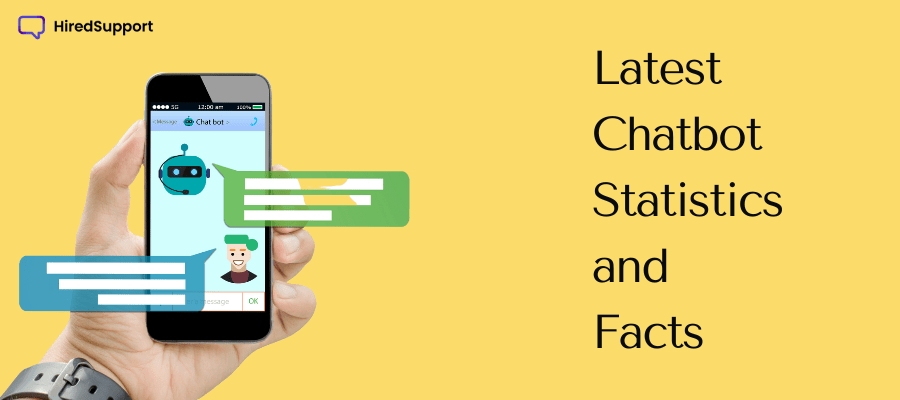
Chatbot statistics reveal a significant increase in user engagement and acceptance of chatbot technology. With 1.4 billion people using messaging apps and expressing willingness to interact with chatbots, businesses have recognized the potential. B2B companies lead the adoption of chatbots, with 58% utilizing them on their websites. The customer perception of chatbot experiences remains positive, with an average satisfaction rate of 87.2%. While some consumers still prefer human support and express concerns about chatbot capabilities, the majority are open to using chatbots for support and purchasing decisions.
Table of Contents
Having spent years in the BPO industry, I observed the rapid rise in chatbots throughout the years.
Not only chatbots but the rapid rise in the use of automation and AI to ease human tasks in general as well.
Similarly, the adoption and utilization of chatbot technology in various sectors have seen an upward trend in recent years.
A chatbot is a sophisticated piece of software designed to automate interactions with customers, improve user experience, and save time for both businesses and customers.
As the world rapidly embraces digital transformation, the use of chatbots has become even more relevant in today’s dynamic business landscape.
From handling customer service inquiries to resolving complaints, providing information, or assisting with purchases, chatbots have proven to be an invaluable tool for businesses across industries.
In this blog post, we will explore some interesting chatbot statistics and facts in 2023 that underline their growing significance.
Recommended reading: The Great Chatbots Debate: Do Consumers Prefer Them?
Latest Chatbot Statistics 2023
User Engagement Statistics
- 1.4 billion people use messaging apps and are willing to talk to chatbots. (99Firms)
- 40% of millennials claim to engage with bots on a daily basis. (Mobile Marketer)
- On the low end, low engagement bots see 35-40% response rates. On the higher end of the spectrum, better bot experiences can result in 80-90% response rates. (Matthew Barby)
- Users have a growing willingness to engage with chatbots in a variety of ways, with usage for purchases, meeting scheduling and mail list sign-ups more than doubling from 2019 to 2020. (Drift)
- 67% of worldwide consumers interacted with a chatbot to get customer support over the past 12 months. (Invesp)
- In 2020, 41.3% of consumers said they used chatbots for purchases. (Drift)
- 56% of customers prefer to message rather than call customer service. (Outgrow)
User Perception Statistics
- The #1 predicted use case for chatbots is “getting a quick answer in an emergency”. The #2 use case is “resolving a complaint or question”. (Drift)
- 35% of people use chatbots to resolve a complaint or problem, or for getting detailed answers. (Drift)
- 87.2% of consumers rate their typical chatbot experience as within the range of neutral to positive. (Drift)
- The top concerns people have when using a chatbot for their customer service questions? A lack of understanding the issue. Or the bots inability to solve a complex issue or problem. (NewVoiceMedia)
- 27% of consumers were unsure if the last customer support interaction they had was with a real person or a chatbot. (PwC)
- 34% of retail customers would be comfortable speaking with customer service through AI chatbots instead of a live customer support representative. (Statista)
- Only 9% of consumers think that companies should never use chatbots. (Userlike)
Impact on Business
- 58% of B2B companies use a chatbot on their website, as compared to 42% on B2C websites. (Relay)
- Chatbots saw a 92% use increase since 2019, making it the brand communication channel with the largest growth. (Drift)
- 46% of companies leveraging intelligent assistants or AI chatbots use them for voice to text dictation. (Spiceworks)
- The #1 department supported by businesses who use chatbot technology is IT, at 53% of organizations. (Spiceworks)
- Chatbots can help businesses save up to 30% on their customer support costs. (IBM)
- 64% of businesses believe that chatbots will allow them to provide a more customized support experience for their customers. (Statista)
- Consumers cite “24-hour service” as the biggest benefit of having chatbots available for the online services that they use. (Drift)
- The top 5 industries profiting from the incorporation of chatbots are real estate (28%), travel (16%), education (14%), healthcare (10%), and finance (5%). (Chatbots Life)
- eCommerce stores adopting Facebook Messenger along with an abandon cart chatbot have started to boost revenue by 7-25%. (Chatbots Magazine) Additionally, 55% of businesses using chatbots have generated a greater volume of high-quality leads. (Drift)
Future Predictions and Trends
- The chatbot industry is projected to reach a market size of $3.62 billion by 2030, with an annual growth rate of 23.9%.
- Businesses’ average conversational AI investment is set to reach $18.4 billion by 2026.
- By 2023, 75-90% of queries are expected to be handled by chatbots. (Juniper Research)
- Smart TVs will have the most significant expansion, predicted to grow by over 100% every year for the next five years.
- By 2024, it’s predicted that the amount consumers spend via chatbots will reach $142 billion worldwide, increasing from just $2.8 billion in 2019.
- $11 billion could be saved annually by the adoption of chatbots in healthcare. (MedCity News)
- 30% reduction in operational costs thanks to chatbots. This suggests a trend towards cost savings through the use of chatbots. (Source: Marketing Insider Group)
- Juniper Research estimates that chatbots will account for $112 billion in retail sales by 2023. (Mobile Marketer)
- By 2024, the global chatbot market is projected to be over $994 million. (ClickZ)
Resistance and Preferences
- A study conducted by NewVoiceMedia found that 46% of consumers felt chatbots were being used to prevent them from reaching a live person. (NewVoiceMedia)
- 60% of consumers believe a human can better understand what they need as compared to a chatbot. (Business Insider)
- 60% of people still prefer to wait for an agent rather than talk to a chatbot. (Userlike)
- 48% of people care more about a chatbot being able to solve their issues over it having a personality. (Business Insider)
- 46% of respondents in a Usabilla survey said they would choose a live person over a chatbot even if engaging with a chatbot saved them 10 minutes. (Usabilla)
- 60% of consumers aged 35-44 believe companies are too quick to replace human representatives with chatbots. (CGS)
- 40% of consumers have no preference when it comes to engaging with a chatbot or a human for help, as long as they receive the support they need. (HubSpot)
Application and Effectiveness Statistics
- Willingness to use chatbots for purchases rose from 17.1% to 41.3% from 2019 to 2020. (Drift)
- 33% of consumers want to be able to use a chatbot to make a reservation at a hotel or restaurant. (Drift)
- 64% of customer service agents who utilize AI chatbots are able to spend most of their time-solving difficult cases. (Salesforce)
- On average a customer service agent handles 17 chats daily. (LiveChat)
- 67% of internet users have used social media, live chat, or texting to contact customer service. (eMarketer)
- Chatbots can take care of 30% of live chat communication. (LiveChat)
- 83% of customers are satisfied while being served by a chatbot in the Insurance industry. (LiveChat)
- In 2022, the average queue waiting time was 5 min 16 sec. Chatbots could shorten that time helping companies to increase customer satisfaction. (LiveChat)
- 29% of customers drop the queue when a brand doesn’t respond to their questions instantly. (LiveChat)
Market Statistics
- In 2021, there was a 43% rise in the number of chats compared to 2020. (LiveChat)
- Businesses spend over $1.3 trillion per year to address customer requests. Chatbots can help to reduce customer support costs by 30%. (IBM)
Recommended: How Chatbots Will Transform Customer Service
Conclusion
As the statistics above show, chatbots have become an integral part of the digital landscape and a critical tool in enhancing customer experience.
The adoption of chatbot technology is increasing at an unprecedented rate as businesses realize their potential in various aspects of customer service, engagement, and support.
Despite some challenges, the future of chatbots looks promising with continuous improvements in AI technology and machine learning, which will enable chatbots to deliver even more personalized and accurate service.
Embracing chatbots is not just a trend; it’s a strategic move that can significantly impact business operations and customer satisfaction as backed by these chatbot statistics.


